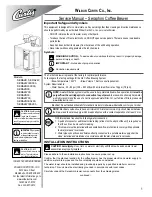
6.3 Transferring a patient
Lifting from a seating surface
1.
Before proceeding, review the information and observe
all warnings indicated in
and
2.
If applicable, ensure the brakes of the stationary object
(e.g. bed, wheelchair etc.) are applied.
3.
Position the sling around the patient. Refer to your sling
user manual.
4.
Adjust the lifting arm to the patient height, if required.
See
5.
Unlock the rear castors of the lift. See
.
6.
Open the legs of the lift to maximum. See
7.
Use the push bar to move the lift into position.
•
For transferring a patient from a bed the legs of
the lift are placed under the bed
•
For transferring a patient from a wheelchair,
commode, chair etc. the legs of the lift are placed
on each side of the stationary object.
8.
Instruct the patient to place their feet onto the foot
plate and their lower legs against the leg support. Assist
the patient if necessary and ensure proper placement of
the feet on the foot plate
9.
Ensure the upper edge of the leg support cushion is
placed about 2 fingers below the kneecaps (patella)
of the patient. Adjust the height of the leg support if
necessary. See
.
10. If applicable, adjust and apply the leg band around the
patients lower legs. See
11. Lower the patient lift for easy attachment of the sling.
See
.
12. Lock the rear castors of the lift. See
13. Attach the sling. See
6.2 Attaching the sling to the lift,
14. Unlock the rear castors of the lift. See
.
15. Instruct the patient to hold onto the hand grips on both
sides of the lifting arm.
16. Instruct the patient to lean back into the sling.
17. Press the UP arrow button on the hand control to raise
the patient above the stationary object. See
18. Before moving the patient, check again to make sure
that the sling is properly connected to the hooks of the
lifting arm. If any attachments are not properly in place,
lower the patient back onto the stationary object and
correct the problem.
19. Using the push bar, move the lift away from the
stationary object.
Lowering to a seating surface
1.
Before proceeding, review the information and observe
all warnings indicated in
and
2.
Ensure the patient is raised high enough to clear the
surface to be transferred to. Raise the patient and/or
lower the stationary object if applicable.
3.
If applicable, ensure the brakes of the stationary object
(e.g. bed, wheelchair etc.) are applied.
4.
Position the patient as far over the seating surface as
possible.
•
For transferring a patient to a bed the legs of the
lift are placed under the bed
•
For transferring a patient to a wheelchair, commode,
chair etc. the legs of the lift are placed on each
side of the stationary object.
5.
Press the DOWN arrow button and lower the patient
onto the seating surface. See
6.
Lock the rear castors of the lift. See
7.
Unhook the sling from all attachment points on the
stand assist lift.
8.
If applicable, remove the leg band from around the
patients lower legs. See
9.
Instruct the patient to lift their feet off of the foot plate.
Assist the patient if necessary.
10. Unlock the rear castors of the lift. See
11. Move the lift away from the stationary object.
12. Remove the sling from around the patient.
The patient can remain in the Invacare® Stand
Assist sling while using the commode. In this
case the sling must not be placed around the
patient again before lifting from the commode.
60127405-A
21
Summary of Contents for ISA COMPACT
Page 34: ...Notes ...
Page 35: ...Notes ...















































